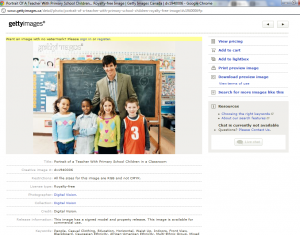 Critical Thinking Images on websites is our third episode in our series about using photos on blogs.
Critical Thinking Images on websites is our third episode in our series about using photos on blogs.
- Use free photos on your classroom blog to make your writing (and your students’ writing) more interesting.
- What is stock photography? Why did I decide to go with Big Stock Photo on this blog.
- Today’s post is to help teachers get students critical thinking images, videos, and other content that we see on websites, brochures, advertisements, etc.
- The next post is to give you two tools to tell if the people in any photo are professional models (i.e. is this a stock photograph?)
People use stock photography because it’s quicker, easier, and cheaper than hiring a photographer. Royalty-free stock photography is not exclusive, which means that anyone can buy that photo and use in their projects.
That’s why you sometimes see the same photo (like the one at the top of this post) appearing over and over again. We need our students to be critical thinking images that we see.
Using Photos on Blogs – Part 3: Critical Thinking Images on Websites
- Critical Thinking Images through with 5 Guiding Questions (Media Literacy)
- The question becomes (when) can you use a fake shot (i.e. stock photography) to make a real point?
- Is it wrong for a documentary to use a fabricated Hollywood shot to make a point, even if there’s science behind it?
- Should the images on a dentist’s website accurately represent their patients?
- Should the images on a politician’s website accurately reflect the people they represent?
- Should the images on a district school board’s website accurately reflect the students and teachers in that school board?
- This post was written using Dragon NaturallySpeaking 11.5 Premium Wireless. Find out more about Dragon NaturallySpeaking.
Critical Thinking Images through with 5 Guiding Questions (Media Literacy)
Media literacy is the idea about thinking more critically when we consume different types of media – reading, writing, computers, art, TV, newspapers, magazines, film, billboards.
For example, if we know that media is constructed then we know that some careful decisions were made to choose the images that were used in a website, book or an advertising campaign. That’s why students need to be critical thinking images that we see instead of simply assuming that wearing these running shoes will make me fit like that athlete in the commercial.
If we look at the Center for Media Literacy MediaLit kit, there are five key questions that we can use to critically think about media:
- Who created this message?
- What creative techniques are used to attract my attention?
- How might different people understand this message differently?
- What values, lifestyles and points of view are represented in, or omitted from, this message?
- Why is this message being sent?
The question becomes (when) can you use a fake shot (i.e. stock photography) to make a real point?
When is it appropriate to use images of paid models to prove your point, or to make a sale? Students can debate on the following examples by reflecting on the five key questions for media literacy from above.
- Is it appropriate for a fact-based documentary to use staged shots?
- Is it appropriate for a dentist to show models with perfect teeth?
- Is it appropriate for politician to show images of people from outside of their constituency?
- Is it appropriate for a school board to show images of students that “the schools?
Is it wrong for a documentary to use a fabricated Hollywood shot to make a point, even if there’s science behind it?
That’s the question that ABC News asks when they showed that Al Gore used a computer-generated Hollywood movie scene in his documentary about global warming.
- In “An Inconvenient Truth,” Al Gore shows the scene of Antarctic ice shelves breaking into the water as part of his documentary about global warming.
- ABC news reports that the scene come from the beginning credits of “The Day after Tomorrow.” More information is on the NewsBusters site.
- Students critical thinking images in this documentary should ask themselves, does it make the science any less credible because they used a Hollywood shot?
Should the images on a dentist’s website accurately represent their patients?
If you offer dental braces, and other dental treatments that are necessary “to develop and maintain a healthy, beautiful smile, “should the images of the smiling people on your website be real patients, or can they be professional models from stock photos?
Here is a photo of smiling teens on an orthodontist website: “Your new smile is waiting – call us today.”
Here’s another orthodontic center with the same image. The caption underneath the bottom right photo says “creating beautiful smiles is our business. Come take a look at some of our smile transformations.”
Here’s the website for a dentist who specializes in innovative cosmetic dentistry. If you check out their page for “Invisalign Teen,” you see the same photo of four smiling teens.
This stock photograph comes from Yuri Arcurs who is the “world’s top selling microstock photographer” and who published this shot on Big Stock Photo (which, incidentally, is where I buy the images on this blog. )
Students critical thinking images in this series of dental websites should ask themselves whether these images impact sales. (If you used a different photo, would it make a difference?)
Should the images on a politician’s website accurately reflect the people they represent?
Here are some examples in Canadian politics where political parties are using stock photography. Students critical thinking images in these websites should ask themselves what messages do these images send? Why did they decide to use these photos and would it have made a difference if they used photos of actual people in their constituencies?
- The Conservative party of Canada website uses stock photography – a heartwarming hunting photo from Minnesota.
- A Liberal French language television ad uses stock photography.
- A Conservative MP had “ethnic people in stock photographs” on his website.
- A Liberal platform book and Conservative TV commercial both use the same little girl (albeit different images.)
Should the images on a district school board’s website accurately reflect the students and teachers in that school board?
The Toronto District School Board is the largest school board in Canada and the fourth largest school board in North America. They serve over 250,000 students. They also use stock photography on their website. Students critical thinking images in these school district websites should ask themselves what the message is in this website and whether using professional models of teachers and students impacts the message.
Here’s an image of their district website (Jan 7, 2012). Look carefully at the bottom image of the teacher with four students in front of a chalkboard (TDSB_homepage_schools_pic.jpg)
The portrait of a teacher with primary school children in the classroom is a stock photo from Getty images.
Incidentally, the Toronto District School Board is not the only school district to use this image. Independent School District 196 in the United States also uses the stock photo.
Stay tuned. Using Photos on Blogs, Part 4:
Next time in our series on using photos on blogs, we’ll look at some internet tools used on today’s post about critical thinking images on websites. That way, you can find your own examples of websites and posters that use stock photography to help get your students critical thinking images that were used.
Image Source: Big Stock Photo / Yuri Arcurs
This post about Critical Thinking Images and the previous post in the series about Big Stock Photo were written together at the same time using Dragon NaturallySpeaking 11.5 Premium Wireless. What is Dragon NaturallySpeaking?
- Find out how accurate Dragon NaturallySpeaking was in the writing of these two posts.







Leave a Reply